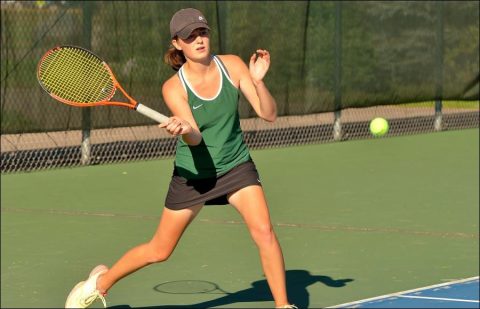The first step in acquiring good strokes is to learn the correct grips-notice I said grips, not grip, for no one grip will do for all strokes. You will hear much talk about the three schools of gripping the racquet:
The Eastern grips-which are correct; the Continental grip-which is included in the Eastern style for certain strokes; the Western grip-which is obsolete and discarded today by experts.
Since I am convinced that the Eastern grips are best, I will discuss them only-for in doing so, I bring in the Continental, or Universal, grip where it belongs.
The Eastern Grips. There are three distinct grips within the Eastern school.
1. The forehand· drive grip-the key grip from which you learn the others.
2. The backhand drive grip.
3. The Continental grip, or Eastern service, which is used for all strokes except the drive.
1. The Forehand Drive Grip. Hold the racquet in the left hand so the short strings are perpendicular to the ground, with the handle pointing at you. Then (assuming you are right-handed), place the palm of the right hand flat against the flat side of the handle at the back (or right-hand side), away from the direction you would hit the ball (to the left), so that the handle and your arm make a straight line. Close the fingers firmly around the handle with the fingers spread comfortably. Notice that now the face of your racquet and palm of your hand are in the same hitting plane, and there is practically no broken line at the wrist. This is the key grip of the Eastern school and is the one that should always be learned first.
2. The Backhand Drive Grip. Still holding the racquet as described above, learn the move to the second grip, the backhand grip. Move the hand backward (or counterclockwise) a quarter-circle turn until the palm of the hand is on top of the handle with the flat side of the top resting in it, and the arm still making nearly a straight line with the handle. Close the fingers firmly around the handle with the thumb diagonally across the handle, not straight up the back. In hitting the ball, you use the opposite face of the strings from the forehand.
These two grips, as described, are used to hit all fiat and topspin drives, fore- and backhand. They are not used for any strokes except drives.
3. The Continental Grip. This grip, which is also known as the Eastern Service grip or the Universal grip, is used for grip, is used for the chop and slice stroke, the volley, the smash, the lob, and the drop shot, as well as for the slice, twist and cannonball service. It should never be used to drive, particularly off the forehand, where it lacks power. Half-way between the handle positions of the fore- and backhand grips is a slanting surface of the handle.
Starting from the original forehand key position, move the hand an eighth-circle turn backward, or counterclockwise (which is half of the way to the backhand grip), until the palm of the hand lies on this slanting surface of the handle. Then dose the fingers firmly around the handle, let the thumb take a natural diagonal position across the handle, and depress the wrist, making an angle with the handle of the racquet that will bring the he ad of the racquet above the wrist.
The hand in position is not materially changed, only eased between forehand and backhand. Do not grip the racquet so tightly that it will cramp the arm muscles, but do not go too far the other way by holding the racquet so loosely that it will turn easily in the hand. The time to ho Id the racquet firmly is at the moment of impact with the ball.
Many players feel that they haven’t time to change the position of the hand on the racquet handle. Actually, they have more than enough provided they know how to do it. Do not attempt to turn the racquet in the hand but move the hand on the handle, keeping the racquet still. Do this by steadying the racquet in your left hand and moving the right hand into the correct position by sliding it around the handle.
Remember that correct grips are a vital part of a sound shot. Even if at first these grips seem slightly unnatural, stay with them until they are mastered. Many players have great difficulty in learning to serve with this grip, because it does not feel natural to them, but let me strongly urge you to stay with it until you have it, since time has proved it is by far the best service grip.
For the sake of continuity, I am writing of service first, for it is the opening stroke in every point in tennis, but in actually coaching the game I advocate learning the forehand drive first, then service, because it is easier to get the feel of the racquet on the forehand. However, in order of learning from a book, the service takes first place.
